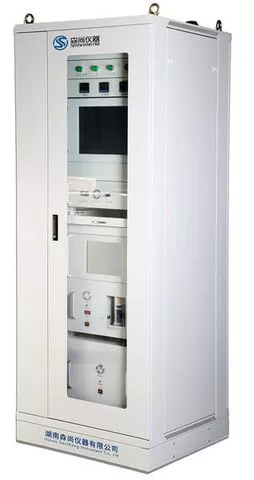Description
I. Overview of the SYSTEM
The ss-600c flue gas emission monitoring system is a continuous on-line measurement of the NO/SO2/O2 content, flue gas flow, dust, temperature, pressure and humidity of the factory by industrial instruments.
CEMS System Composition:
1). Continuous monitoring system for gaseous components of flue gas
2). Particulate matter concentration detection system
3). Auxiliary parameter Detection system (temperature pressure flow humidity)
4. Data acquisition and processing system DAS. The smoke gas pollutant detector adopts the direct extraction method (the heating pipe) to measure the pollutant concentration in the flue gas, the instrument is easy to maintain, the calibration is convenient, the instrument failure rate is low, the gas analysis uses the non disperse infrared absorption method, uses the electrochemical method to measure the dry oxygen concentration, the flue gas flow measurement adopts the integrative pitot pressure difference method, the measurement is more accurate,
The pressure transmitter is used to measure the flue gas pressure, the thermal resistance Pt100 is used to measure the flue gas temperature, and the laser scattering method is used in the smoke detector.
Data acquisition system Das can be measured by processing and storage, can be through the network or output standard current signal Plant DCS connection, you can easily and quickly call to view the monitoring data, and the sulfur content of nitrogen content at any time to adjust the catalyst added
Ii. Scope of application
Applicable scope
Applicable to power plants, smelters, cement plants, all kinds of industrial kilns, boilers and other flue gas ultra clean emission monitoring.
Third, technical parameters
Analysis of monitoring points to range of components
Flue gas emission SO2 0-250-2500ppm (other quantity Cheng)
NO 0-250-2500ppm (Other quantity Cheng)
O2 0-10%-25%
Temperature 0-300 ℃
Pressure -5-5kpa (relative pressure)
Flow rate 0-30m/s
Soot 0-50mg/nm3
1, the highest sampling temperature: 400 ℃
2. Maximum working pressure: 6BAR
3, heating temperature: sampling probe 140 ℃ (factory set, temperature adjustable)
120 ℃ of Heating pipe
5, ambient temperature:-20~60℃
6. Maximum dust concentration: 100g/m3
7. Filtration Accuracy: 0.1μm
8, pretreatment sample Gas dew point: 4 ℃
9, linearity: ≤1%
10. Precision: ≤1%
11, 0 point drift: ±2%/Week
12, the Range Drift: ±2%/week
13. Calibration Mode: Manual/Automatic
14, communication interface: RS485,4-20MA Standard current
Iv. Characteristics of products 1.
Anti-blow function: Designed CEMS smoke sampling probe, smoke meter with automatic purge function. 2.
Self-diagnosis and alarm function: self-diagnosis and alarm content at least includes: detection source and probe failure, the limit of each monitoring items (up/down), sampling probe temperature alarm and the main instrument components (such as the instrument cover high and low temperature) abnormal alarm. 3.
Indication function: DAS can indicate the above mentioned self-diagnosis and alarm contents as well as the contents of the analyzer in the calibration cycle, the system's reverse-blowing indication, the sampling gas path flow, etc. 4.
Other functions: The main analysis instrument self-diagnosis, automatic control, automatic calibration, system networking, error code indicators and other functions. 5.
Data processing System: The selected Das is for the flue gas desulfurization and denitrification system monitoring software, the monitoring data of desulphurization and denitrification can be displayed at the same time, stored and processed, the efficiency of desulphurization and denitrification system is obtained, and all monitoring data are stored and the report is generated so that the monitoring data at any time is viewed. 6. CEMS has high reliability, security, maintainability and scalability.
The monitoring equipment fully meets the requirements of the 24-hour continuous monitoring operation of desulphurization and denitrification process, aiming at the various parameters in the denitrification process and monitoring the changes of parameters in real time. 7.
reported flue gas flow = wet flue gas volume x (Atmospheric pressure + flue gas static pressure)/101300x273/(273+ flue gas temperature) x (1-flue humidity), including temperature, pressure, humidity correction for the standard dry flue gas volume. 8.
The configuration software is suitable for the hardware resources of the system, besides the system software and application software, the on-line fault diagnosis is also configured. 9.
The analytical instruments and monitoring instruments designed by CEMS include an electrical signal interface for daily maintenance personnel maintenance, which greatly facilitates the maintenance of technicians. 10.
All flue equipment can be used in the following harsh environments: Flue pressure (4.9 to +4.9kpa), chimney inlet temperature (less than 300 ℃), relative humidity (less than 95%). 11.
The probes and other parts of the CEMS design which are in contact with flue gas or school upright are made up of corrosion resistant 316L stainless steel and PTFE materials. 12. Using electric heating Control Win Gan method Sampling way, the auxiliary link is few, the reliability is high, can reflect the content of flue gas component truly, have no additional error, so the measurement precision is high.
- Flue Gas Monitoring System
Production Capacity:
Not informed
Delivery Timeframe:
Not informed
Incoterms:
Not informedPackaging Details:
Not informed
More about
SENSHANG INSTRUMENT
Not informed
Not informed
Not informed
Year
Established
Business type
- Industry / Manufacturer
Keywords
- CESM
- VOCS
- TDLAS system
- gas analyzer
- gas monitoring system
Contact and location
-
Carol ********
-
+86 73********
-
Changsha / Hunan | China






